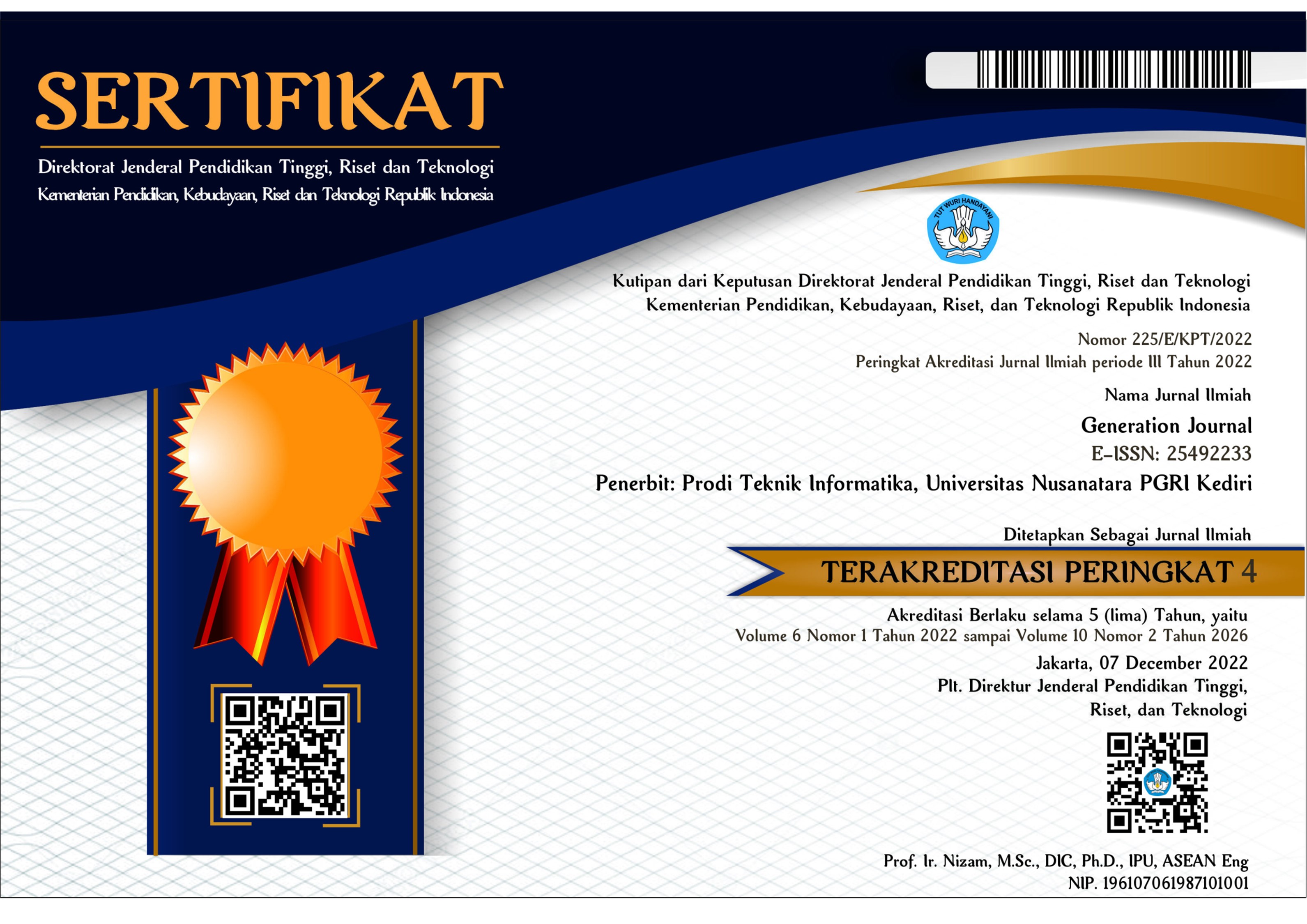Penerapan Metode XGBoost Untuk Memprediksi Jumlah Kejadian Kecelakaan Lalu Lintas di Kota Banjarmasin
DOI:
https://doi.org/10.29407/gj.v7i1.19807Keywords:
rainfall, traffic accident, prediction, xgboostAbstract
Setiap tahunnya terjadi kecelakaan lalu lintas seperti yang tercatat pada data dari Polisi sejak tahun 2016 sampai dengan 2020 yang ditambah dengan data dari sosial media pada tahun 2021 sampai bulan Oktober. Selain berdasarkan data kecelakaan lalu lintas terdapat juga hal yang dapat mempengaruhi terjadinya kecelakaan seperti curah hujan. Berdasarkan permasalahan tersebut, penelitian ini akan melakukan prediksi terhadap jumlah kejadian kecelakaan lalu lintas yang akan terjadi di kota Banjarmasin menggunakan metode XGBoost. Data yang telah dikumpulkan akan diolah dalam rentang waktu bulanan serta pengujian model menggunakan dua metode yaitu RMSE untuk melihat tingkat error rate hasil prediksi dengan nilai nyata dan R-Squared atau R2 untuk melihat korelasi kecelakaan dengan curah hujan. Hasil penelitian menunjukkan metode XGBoost mendapatkan nilai RMSE sebesar 0.120 pada data per hari dengan variabel kecelakaan saja sedangkan nilai R2 mendapatkan 0.19 pada data per 4 bulan kebelakang dengan variabel kecelakaan dan curah hujan.
References
Marroli, “Rata-rata Tiga Orang Meninggal Setiap Jam Akibat Kecelakaan Jalan,” Kementerian Komunikasi dan Informatika (KOMINFO), 2017. https://kominfo.go.id/index.php/content/detail/10368/rata-rata-tiga-orang-meninggal-setiap-jam-akibat-kecelakaan-jalan/0/artikel_gpr
Badan Pusat Statistik, “Jumlah Kecelakaan, Korban Mati, Luka Berat, Luka Ringan, dan Kerugian Materi 2017-2019,” 2020. https://www.bps.go.id/indicator/17/513/1/jumlah-kecelakaan-korban-mati-luka-berat-luka-ringan-dan-kerugian-materi.html
Badan Pusat Statistik, “Jumlah Penduduk (Jiwa), 2018-2020,” 2021. https://banjarmasinkota.bps.go.id/indicator/12/8/1/jumlah-penduduk.html (accessed Sep. 29, 2021).
Badan Pusat Statistik, “Jumlah Kendaraan Bermotor Menurut Kabupaten/Kota dan Jenis Kendaraan di Provinsi Kalimantan Selatan (unit), 2018,” 2018. https://www.bps.go.id/indikator/indikator/view_data_pub/6300/api_pub/V2w4dFkwdFNLNU5mSE95Und2UDRMQT09/da_10/3 (accessed Sep. 30, 2021).
Badan Pusat Statistik, “Jumlah Kecelakaan di Kota Banjarmasin(2019),” 2019. https://banjarmasinkota.bps.go.id/statictable/2015/03/15/437/jumlah-kecelakaan-dan-korban-kecelakaan-lalu-lintas-per-bulan-2013.html (accessed Sep. 30, 2021).
Z. Yuan, X. Zhou, and T. Yang, “Hetero-ConvLSTM,” pp. 984–992, 2018, doi: 10.1145/3219819.3219922.
L. Yu, B. Du, X. Hu, L. Sun, L. Han, and W. Lv, “Deep spatio-temporal graph convolutional network for traffic accident prediction,” Neurocomputing, vol. 423, pp. 135–147, 2021, doi: 10.1016/j.neucom.2020.09.043.
C. Bentéjac, A. Csörgő, and G. Martínez-Muñoz, A comparative analysis of gradient boosting algorithms, vol. 54, no. 3. Springer Netherlands, 2021. doi: 10.1007/s10462-020-09896-5.
X. Dong, T. Lei, S. Jin, and Z. Hou, “Short-Term Traffic Flow Prediction Based on XGBoost,” IEEE 7th Data Driven Control and Learning Systems Conference, pp. 854–859, 2018, doi: 10.1109/DDCLS.2018.8516114.
A. B. Parsa, A. Movahedi, H. Taghipour, S. Derrible, and A. (Kouros) Mohammadian, “Toward safer highways, application of XGBoost and SHAP for real-time accident detection and feature analysis,” Accid Anal Prev, vol. 136, no. December 2019, p. 105405, 2020, doi: 10.1016/j.aap.2019.105405.
H. M. Hammad et al., “Environmental factors affecting the frequency of road traffic accidents: a case study of sub-urban area of Pakistan,” Environmental Science and Pollution Research, 2019, doi: 10.1007/s11356-019-04752-8.
J. Lee, J. Chae, T. Yoon, and H. Yang, “Traffic accident severity analysis with rain-related factors using structural equation modeling – A case study of Seoul City,” Accid Anal Prev, vol. 112, no. November 2017, pp. 1–10, 2018, doi: 10.1016/j.aap.2017.12.013.
J. Lee, T. Yoon, S. Kwon, and J. Lee, “Model evaluation for forecasting traffic accident severity in rainy seasons using machine learning algorithms: Seoul city study,” Applied Sciences (Switzerland), vol. 10, no. 1, 2020, doi: 10.3390/app10010129.
Badan Meteorologi dan Geofisika Jayapura, “Badan Meteorologi dan Geofisika Kota Jayapura,” no. 2, 2006.
G. I. Merdekawati and Ismail, “Prediksi Curah Hujan Di Jakarta Berbasis Algoritma Levenberg Marquardt,” Jurnal Ilmiah Informatika Komputer, vol. 24, no. 2, pp. 116–128, 2019, doi: 10.35760/ik.2019.v24i2.2366.
H. Freecenta, E. Y. Puspaningrum, and H. Maulana, “PREDIKSI CURAH HUJAN DI KAB.MALANG MENGGUNAKAN LSTM (Long Short Term Memory),” Jurnal Informatika dan Sistem Informasi (JIFoSI), vol. 3, no. 1, pp. 2722–130, 2022, [Online]. Available: https://dataonline.bmkg.go.id/data_iklim
Downloads
Published
Issue
Section
License
Authors who publish with this journal agree to the following terms:
- Copyright on any article is retained by the author(s).
- The author grants the journal, the right of first publication with the work simultaneously licensed under a Creative Commons Attribution License that allows others to share the work with an acknowledgment of the work’s authorship and initial publication in this journal.
- Authors are able to enter into separate, additional contractual arrangements for the non-exclusive distribution of the journal’s published version of the work (e.g., post it to an institutional repository or publish it in a book), with an acknowledgment of its initial publication in this journal.
- Authors are permitted and encouraged to post their work online (e.g., in institutional repositories or on their website) prior to and during the submission process, as it can lead to productive exchanges, as well as earlier and greater citation of published work.
- The article and any associated published material is distributed under the Creative Commons Attribution-ShareAlike 4.0 International License














